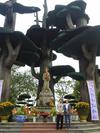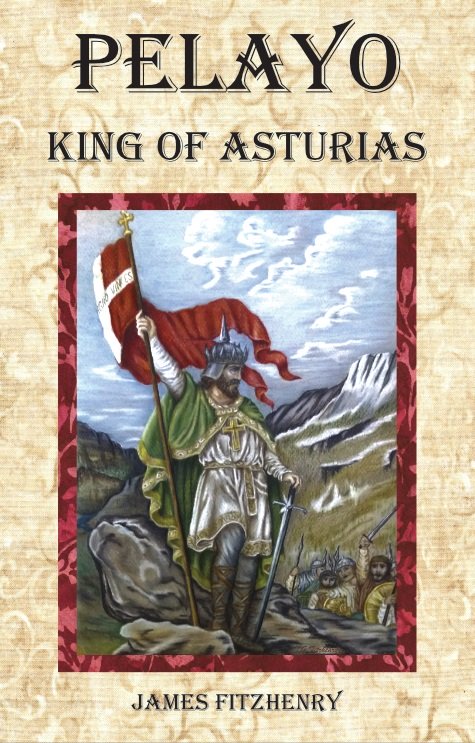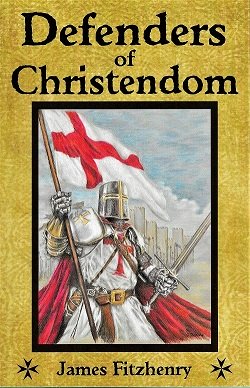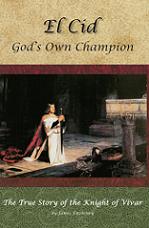Our Lady of Lavang
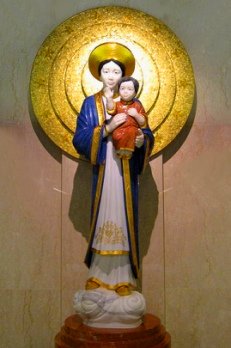
November 22: Our Lady of Lavang, Viet Nam (1798)
The fact that the Blessed Virgin visited a small group of Catholics in the little jungle village of Lavang, in Viet Nam, in 1798, is not surprising to anyone who knows the ways of the Mother of God. She has always been faithful to her children by grace.
It was as a result of one period of persecution that a number of Vietnamese Catholics found refuge about 1785 in a jungle that hardy foresters would hesitate to penetrate. Here they stayed hidden, suffering privations, dangers, and illnesses, in order to practice their religion. One of the few comforts they had was reciting the rosary every day at dusk.
On one such evening, they were first frightened and then enchanted to behold a Woman and Child standing nearby in a mysterious glow of light. Simple as these people were, some among them recognized the Virgin Mother and Her Child. All listened entranced while Mary told them softly that she was fully aware of their hardships and of their chronic sickness due to contaminated water. She told them to gather certain leaves that grew near and make a strong tea of them; this would keep them healthy. Solemnly she added, “From this day on, prayers said on this spot will be heard – and answered.” The year was 1798.
Our Lady of Lavang
Not long after the Virgin’s visit, the people heard that the persecution they escaped had ended. Most went back to their original homes; they could talk about little but the apparition they had seen, and word of this miracle spread.
By 1820 even the Buddhists believed in Our Lady’s promise and built the first little shrine, a pagoda, on the spot where Mary had been seen. Within a short time these Buddhists become Christians; and their small shrine became the first Church of Our Lady of Lavang. The faithful found solace and courage in this devotion in times of oppression and general misery that have come again and again to the Vietnamese.
In 1885 during a period of rabid anti-Christianity, the Lavang chapel was burned; a priest, Father Philip Minh, now Blessed Philip, was beheaded. There was another lull between attacks and work was begun on a building to replace the burnt chapel.
There were great difficulties in transporting supplies plus a lack of adequate funds, but the great church of Our Lady of Lavang somehow evolved to completion and was dedicated in 1901 in the name of the Protecting Mother of the faithful. A congress of all dioceses of Viet Nam was called and Lavang became a place of pilgrimage for countless devout people of Southeast Asia.
During the Marian Congress of 1961, a new basilica of Our Lady of Lavang was dedicated by Archbishop Peter Ngo-Dinh Thue of Hue. At that time he told Catholics of South Viet Nam that he received messages still from Catholics in North Communist Viet Nam who say they never fail to believe that the Holy Virgin of Lavang will one day deliver their country from Communist oppressors.
Viet Nam is a land of many martyrs. Across the centuries, devoted religious, scholars, leaders and the poor have paid homage to Mary.
Our Lady of Lavang.
*from The Woman in Orbit
A submission from Ann Chatham, NSW Australia.
I struggle with my faith as do many Catholics in this modern times. I was asked by a friend to go over to Vietnam and teach English for a short time. My friend is a Vietnamese nun living and working in Australia. Her convent is in Hue where there is a large group of nuns who needed more exposure to English during their years of formation. I fitted that bill. I am a retired teacher with some time on my hands.
While I was in Hue some of the sisters took me to the shrine to visit and to pray. We spent the day there; we had a walk around, some lunch and then I wandered off on my own. I stood at the foot of the shrine and told Our Lady all the things I thought was wrong with my faith and the Catholic Church in general. It was at that point when I began to tremble and cry. Not a dramatic display but a soft and gentle conversation.
My students gave me a statue of Our Lady of La Vang to bring home to Australia.
Being the person that I am I decided to find some more information about my new statue. This is where I found you.
At this website I found a comment: " Our Lady of La Vang continues to inspire those who suffer for their faith."
I thought I went to Vietnam to teach but I was wrong.
I went to learn.
Ann Chatham
Thank you for your submission, Ann!
Pilgrimage to La Vang - A Dying Man's Last Journey
This submission is from a man who identified himself only as "Rob" from Ha Long City, Vietnam
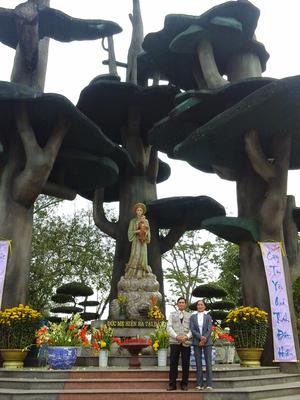
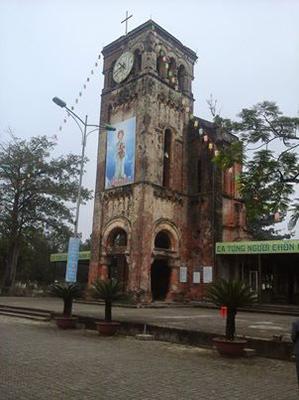
About 10 years ago, while walking through the Basilica of Saint Mary in Minneapolis, Minnesota, I came across an unusual statue of The Blessed Mother with the Christ Child. Having seen statues and shrines to her my entire life, this one was very different from the traditional images of Mary I was familiar with throughout my Catholic upbringing. It was a white porcelain figure dressed in some sort of Asian attire. I thought, ‘huh, that’s curious’. My longtime companion, herself a devoted Catholic from Vietnam, caught up with me and stopped to pray at the shrine. And then she said, ‘she’s so beautiful’. I asked what the deal was with her wearing traditional Asian clothes, I had never heard of that. She shook her head and mumbled, ‘you have so much to learn’. It’s Đức Mẹ La Vang, Our Lady of La Vang.
Spending time with Vietnamese Catholics over the years, I saw images and statues of Đức Mẹ La Vang often, yet never gave her much thought other than finding quite interesting that the Vietnamese has their own Marian apparition. I realized that the Blessed Virgin Mother is very well traveled and comforts Catholics around the world in all times. But I had no idea of her significance to the Vietnamese. What I learned subsequently is that Our Lady of La Vang is of supreme importance to Vietnamese Catholics, having served as an inspiration and source of comfort over the years of violent persecution and discrimination. This very website gives a good account of the story behind La Vang.
Vaguely aware of the Catholic migration to the south to escape violent reprisals in the 1950s, I found a flourishing community when I came to Saigon in 2008 on a volunteer mission. I stumbled across several Catholic churches and prayed daily for guidance at an elaborate grotto I happened upon. I marveled at the devotion the Vietnamese Catholics had for their faith. Much more so than the US or Europe, persecution and martyrdom is within living memory for them. I wanted to stay connected to the Catholic community in Vietnam when I settled here in 2009, and found the Cathedral in Hanoi, where I ended up working.
I met a number of Catholics whom all had family in the South, but they themselves tenaciously held onto their ancestral lands in the North, as guardians to their family burial plots and ancient villages. One such village outside Hanoi holds a very special place in the history of Catholicism in Vietnam. It is the final resting place of 13 martyrs who died for their faith, canonized as part of the “117 Martyrs of Annam” (Vietnam) Catholic saints in 1988.
This small nothing of a village, whose over-sized church is a French colonial era version of Notre Dame in Paris, was also known for its fierce protection against persecution in the last century, defending themselves with farm tools and swords against the attempted crucifixion of their parish priest. The man who led this defense had sons all of which he named after weapons. One of his sons, Kien – ‘Sword’ now in his 60s, is a man I have come to know and respect over the last 4 years. A simple farmer, Kien is a gentle and unassuming man, devout to his faith and loyal to his family.
In December 2014, Kien became sick and was brought to Hanoi to see a few doctors. The news was devastating. This kind, benevolent man who raised a wonderful family had terminal cancer of the esophagus and was expected to live at best, 6 months. Poor and with no insurance, I offered to help cover his steep medical bills, which would have ruined his family, still struggling to grasp the news and how to survive without him. However, It would cost as much as 50,000 usd, and it would likely only extend his life another 6 months at best. His family, trying to come to terms with the hard reality they faced, was at a loss.
Then, I came up with an idea. Rapid deterioration and death was inevitable, so rather than spend money to extend his life, which would likely only prolong his suffering, why not give him something to remember? I offered to bring him and his family to Central Vietnam to just relax and enjoy a part of the country they had never seen. They graciously accepted and in mid-February, 2015, we flew to Da Nang to visit a number of locations including Hue and Hoi An. One thing that had not occurred to me was how important it was for them to visit another nearby location: La Vang.
Being villagers with very little experience in cars or buses, they really hated being enclosed – on the bus ride from Da Nang to Hue (about 3 hours apart) they all got sick. Once in Hue, they once again expressed a strong desire to go to La Vang, another 1.5 hours to the north of Hue. I was taken aback that they preferred to go by motorbike. But early the next morning, we jumped on a few motorbikes and headed for the holiest place for Catholics in Vietnam.
Driving by innumerable cemeteries of war dead on the way, we finally arrived in La Vang and I was impressed with its breadth. A large expanse of land with a long, but modest entrance, lined with statues of Catholic saints and sculptures of scenes from Christ’s life. Pulling into the compound, the first thing that stood out was the old church tower, all that remained of the 1928 church which once stood prominently on the site. Unfortunately, being very near the DMZ, La Vang was nearly obliterated in 1972.
What moved me the most as we approached the site of the church steeple was that the site was still there at all. We discovered that behind the crumbling steeple was a long steel Quonset hut. We stepped inside and to my astonishment was a well-ordered church, with a modest, yet dignified altar and statues and other adornments commonly found in Catholic churches in other parts of the world. This simple edifice was erected on the foundation of the 1928 church and has served the Catholic pilgrims to this holy site for years. ‘What an amazing testament to the Vietnamese Catholics’ devotion!’ I thought as I sat in a pew, overwhelmed with emotion.
After spending moments deep in prayer, the family wandered the site. Directly behind the bombed out church we found something even more unexpected. Through the funding of devout Vietnamese Catholics around the world, a grand, new church is in progress. Due to open in 2016, this palatial edifice is certainly a statement of devotion for this holy site.
We then reverently approached the purported location of the 1798 apparition, to the left of the bombed-out church. It was a magnificent statue of our Lady of La Vang and Christ child made of a number of colored types of stone and surrounded by towering concrete trees. We first came to the nearby drinking fountain which is reputed to hold holy water with healing properties. All the family members drank the water and filled a bottle with some of it. I was a bit more nervous, but took on faith that it was at least safe to drink, so I had a little.
We next moved directly to the statue whereby Kien and his wife, Hiep, knelt down and prayed for several minutes. Then one of their daughters, a delightful woman in her mid-twenties, took a series of photos of her parents adoring the Holy Mother. They reached to touch her feet and as I came closer to admire the craftsmanship, I felt the gravity of this location to these people. I noticed Kien had tears in his eyes as Hiep began frantically calling family members, breathlessly telling them they were at La Vang.
Behind the shrine was an equally impressive image. A 100 foot long golden colored Bas relief of the 117 Annam Martyrs served as the central backdrop to carved images of the 14 Stations of the Cross. We spent several more minutes admiring the imagery and praying on the site.
The battery for our only camera died, so I sought out a power source while the family wandered the site. I found an outlet in the Quonset hut church and stayed there to charge it for some time. I sat and contemplated the many things I have done in Vietnam and began to realize that this moment was one of the most important highlights of this simple, gentle family’s lives. I was happy to bring this moment to them, knowing that soon they would need all their strength to endure the upcoming agony.
While I knelt in the church, the family members wandered the compound, stopping to pray at the variety of statues in the garden in front of the active convent. When I felt the charge was enough to take photos to get through the remainder of the pilgrimage, I went out to look for them. Finding each family member deep in prayer at different grottoes, I quietly waited for them to gather and slowly walk back to our motorbikes. They had had a deeply religious experience for which they thanked me endlessly.
We returned to the North just in time for the Lunar New Year and went our separate ways. They to their village to tell of their adventures in the Central part of the country, and I to visit friends in different provinces around the north of Vietnam. I stopped by their home one day, just before returning to Ha Long City, (where I currently work) to find Kien’s condition had deteriorated. Though he struggled somewhat while on our pilgrimage, he was visibly in more pain now. Realizing it may be the last time we saw each other, he gave me a hearty handshake and thanked me over and over for giving him the time of his life.
The morning of March 3rd, 2015, 2.5 weeks after our pilgrimage to La Vang, Kien’s youngest daughter contacted me to say Kien’s condition had gotten far worse. In tears she said it will be very soon, maybe within days. He is suffering greatly and is unable to eat or even drink any longer. Helpless, all I can do is pray that this fine man who never hurt anyone and has lived his life in quiet devotion to his family and his God, will soon be relieved of his suffering and rejoin those who have gone before him.
God speed, gentlest of men. May God hold you in the palm of His hand.
Have A Great Story About This Topic?
Do you have a great story? Have You Visited This Shrine? Share it!
What Other Visitors Have Said
Click below to see contributions from other visitors to this page...
Pilgrimage to La Vang - A Dying Man's Last Journey 




About 10 years ago, while walking through the Basilica of Saint Mary in Minneapolis, Minnesota, I came across an unusual statue of The Blessed Mother with …
Return to Marian Calendar November from Our Lady of Lavang
Return to Titles of Mary from Our Lady of Lavang
Return to Roman Catholic Saints Home Page from Our Lady of Lavang
Now Available!!
Pelayo's resistance initiated the nearly 800-year-long Reconquista to take back his country from the ruthless invader who had conquered his homeland and sought to erase his culture and his faith. His actions would lay the foundations of a Kingdom for Christ that would eventually reach around the world and spread the Catholic faith to millions of souls. Read more...
Please help us continue to bring high quality books to our readers at the lowest possible price! Click the link below! Thank you!
Now Available!
Catholic Vitality Publications presents . . .Brand new by
James Fitzhenry
Now in paperback!
Battles - Honor - Miracles! This
book is filled with amazing stories of little-known Catholic heroes presenting
spectacles of bravery and valor never exceeded in all the annals of history. read more. . .
Now Available for $18.95
Also available:
Catholic Vitality Publications
Roman Catholic books currently published by Catholic Vitality Publications:
El Cid, God's Own Champion
-the amazing true story of the life of Rodrigo Diaz, El Cid!
Available for only $16.95
St. Fernando III
A Kingdom for Christ
- King St. Fernando III, born 100
years to the month after the death of
the Cid. His life was filled with miracles
and many conquests!
Available now for $26.95
Discounts available for bulk
orders and for bookstore
retail sales! Just contact us
